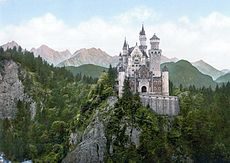Yes, I know you are a little sceptical about the title of this post, but it’s only a bit of a stretch. It happened like this. In 1866 Prince Otto von Bismarck, Chancellor of Prussia fabricated a war against the mighty Austrian empire and, astonishingly, won in just 7 weeks. Austria was kicked out of the German Federation and Prussia adopted her former German allies, including Bavaria.

Four years later, Bismarck’s target was France, considered invincible – by all except Bismarck. Although he hated war, King Ludwig was forced by treaty to send troops to the support of Prussia. I don’t need to go into the details of the Franco-Prussian War. It is sufficient to say that 10 months after the first salvo, Prussian boots were marching along the Champs Elysees.

Bismarck was now in a position to embark on his ultimate goal: the establishment of a German Empire. Ludwig had high hopes that if an empire was to be formed he might be chosen as its head. After all, he was the direct descendant of the Holy Roman Emperors of yore. But Bismarck hadn’t fought 2 wars – actually, 3; I forgot to mention the Schleswig-Holstein war – in order to elevate Bavaria. No, he wanted to unify Germany under Prussian control. Consequently, he founded the Second Reich. The first was the Holy Roman Empire, the third Hitler’s regime sixty years later.
One by one the other German states signed the unification agreement. Bavaria was promised independent diplomatic representation, a separate army in peacetime, her own railway and telegraph services, control of beer taxes (very lucrative in Bavaria) and the right to grant citizenship if the king would sign. But Ludwig knew it all meant a serious curtailment of his sovereignty and his people knew it would be the end of the old Bavaria.
Bismarck wanted something else from Ludwig. He wanted Ludwig to write a letter to King Wilhelm, appealing to him to accept the imperial crown.
Ludwig was invited to Versailles to join in the celebrations. In order to entice him, it was even suggested he should be offered the bedroom of Louis XIV himself, as it was well-known he admired the absolutist kings of France and was expected to respond to the prospect with transports of delight. He was certainly tempted but (a) he hated his Prussian cousin, Crown Prince Wilhelm and (b) he was already showing a tendency toward isolationism. After some wavering, he instructed his court secretary to pretend he was too ill to travel. The Bavarian cabinet left without him and joined the envoys of the smaller German states.
An impasse had been reached. Ludwig empowered his old friend and Master of the Horse, Count Holnstein, to go to Versailles in secret and determine if the imperial crown was out of his reach and how far Bismarck would go to obtain his cooperation. Holnstein was not the friend Ludwig thought he was. In fact, he decided at some point that the forceful all-powerful chancellor was the man to serve and succeeded not only in getting an interview with him but also persuaded him to draft the letter himself and Holnstein would convince Ludwig to sign it. Off Holnstein went back to Bavaria with the precious letter.
When he arrived, Ludwig was in bed with a toothache. It was a malady he suffered from frequently, as he was fond of sweets. At the end of his life, at the age of forty, he had few teeth left. He was in such excruciating pain that initially, he refused to receive his friend. Holstein practically forced his way into the king’s presence and saw that he had been presented with a golden opportunity. Ludwig was alone, except for servants, and vulnerable. The count declared he had to leave to catch a train for Versailles before 6:30, and Ludwig must sign the letter before then. Failure to do so could result in him being deposed and forced to flee. Poor Ludwig was in a very susceptible mood and Holnstein kept the pressure up until Ludwig asked him to send for pen and notepaper. He didn’t sign the letter Holnstein had brought, and he didn’t copy it word for word. Instead, he rewrote it to give more power to the princes of the states in the new Reich. It became known as the kaiserbrief. Holnstein gleefully dashed off.

So Prussia, which had amply demonstrated its pugnacity in 3 wars within 10 years now had the power and prestige of an empire. It had crushed Austria and humiliated France. And in the Crown Prince mentioned above, a.k.a. Kaiser Wilhelm II, it also had an autocratic and possibly unstable leader with a muscular expansionist policy.
I hate to blame anything on Ludwig – he was such a troubled soul. But I can’t help feeling that without his toothache there would have been no kaiserbrief, and without the kaiserbrief, there would have been no imperial Germany, and without the empire, there would have been no First World War, and with no First World War, there would have been no Second World War.
It’s really quite amazing what little occurrences, inconsequential at the time, might lead to.
Ludwig II is the main character of my novella, Dark Spirit.




